Throughout history, Spain and the Balearic Islands have been both crisscrossed and settled by different waves of invaders, many of whom have left their mark.
While not all of these cultures were necessarily friendly, their contribution to Spain’s landmarks, including its magnificent castles, palaces, ancient roads, towers, walled cities, and grand amphitheaters, is invaluable.
Here are some of the best landmarks in Spain you won’t want to miss.
La Sagrada Famíla, Barcelona
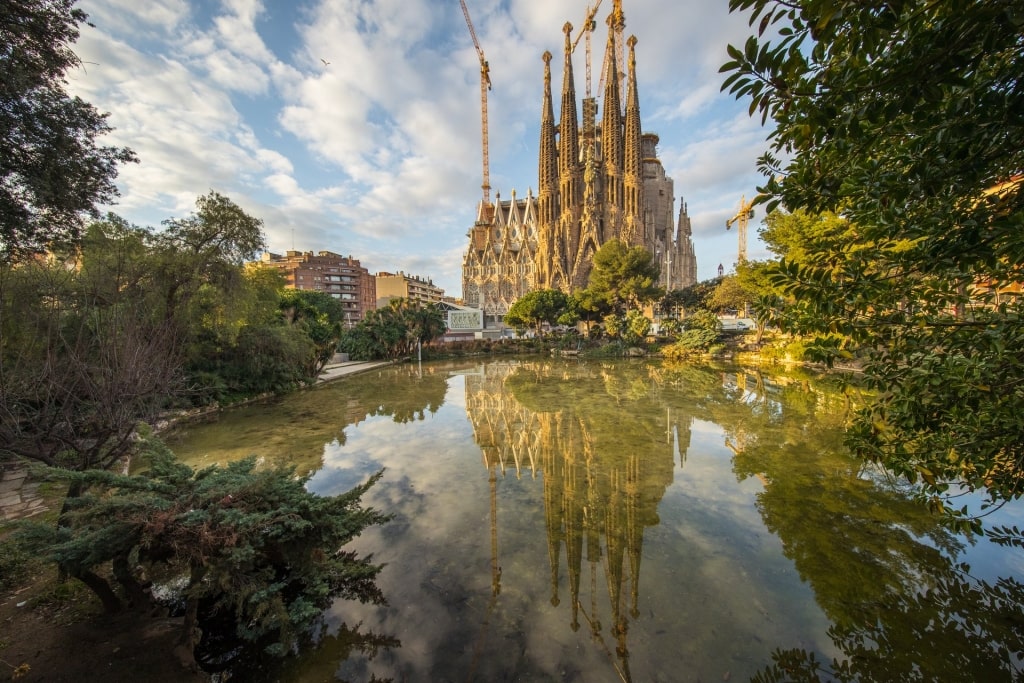
La Sagrada Famíla, Barcelona
La Sagrada Familia is the most distinguishable landmark in Barcelona. Its slender spires tower over the neat grid of the Eixample district, a wealthy neighborhood that was created when the city began to overspill its crowded Gothic quarter.
The church, the legacy of the great modernista architect Antoni Gaudí, has been under construction for 138 years and is still far from finished. But it’s so beautiful, inside and out. The design mimics the organic forms of nature, and the facades are inspired by Montserrat, a mountain and pilgrimage site outside the city.
Inside, you’ll gaze up through what feels like an enchanted forest of skinny columns, the floor bathed in light that filters through elaborate stained glass windows.
This is one Spanish landmark for which you’ll need to book ahead; it pays to skip the line, especially in the heat of summer. If you can, add on a ticket to zoom to the top of one of the towers in the elevator for incredible 360-degree views over the city, the Mediterranean sparkling in the distance.
Gibralfaro Castle, Malaga

Gibralfaro Castle, Malaga
The sturdy Gibralfaro castle, built by the Moors between the 10th and the 14th centuries, looms over the old fortified center in Malaga, called the Alcazaba, with commanding views down over the port.
At one point, Gibralfaro, which served as a military barracks, was considered the most impenetrable castle of the whole of Iberia, thanks to its double walls and solid towers. It fell to the Catholics after a siege in 1487 as the Moors were driven out of Andalucia.
You can walk up the castle via a footpath that starts near the town hall, the route shaded in part by pines, eucalyptus, and tropical gardens. At the top, you can explore the walls and parapets of the castle, which is named after an early lighthouse, Jebel Al Faro, or “Rock of the Lighthouse”.
Alhambra Palace, Granada

Alhambra Palace, Granada
Arguably the most exquisite structure of Andalucia’s Moorish legacy is the Alhambra, just outside Granada, inland from Malaga. One of the most famous landmarks in Spain, the complex was built between the ninth and 15th centuries.
The name means “red fort,” and if you visit in the soft light of morning or early evening, the whole palace glows pinky red, the snowcapped mountains of the Sierra Nevada as a backdrop. At its height, the palace complex contained souks, or markets, a Turkish bath, three palaces, and running water.
A tour takes several hours, and it’s captivating. Every wall in the Casa Real, the main palace, is decorated with intricate mosaics that reflect the sunlight in dazzling colors. The elaborate ceilings are carved from Lebanese cedar.
Leave time on your visit for the Generalife, which once served as a kitchen garden for the palace, growing orange and almond trees, as well as figs and pomegranates. Later, it became a place of leisure for the rulers of Granada. To this day, it is an exquisite ornamental garden of dazzling patios and reflecting pools.
Guggenheim Museum, Bilbao

Guggenheim Museum, Bilbao
Incongruous yet iconic, Frank Gehry’s dazzling, shimmering masterpiece, its exteriors clad in titanium tiles that mimic gleaming fish scales, is a landmark of contemporary Spain. The prows of ships, craggy cliffs, and leaning towers are just some of the features you can pick out in this extraordinary jumble of buildings.
The museum lights up the center of Bilbao, a city that was in the doldrums until Gehry’s creativity was unleashed. In some ways, the building itself overshadows its contents, but if you go inside, expect changing displays of contemporary art alongside the permanent collection, which includes several installations. If you’re not keen on creepy crawlies, look away as you approach Louise Bourgeois’ Maman, a bronze spider nearly 30 feet tall.
Read: Best Things to Do in Bilbao
City of Arts and Sciences, Valencia
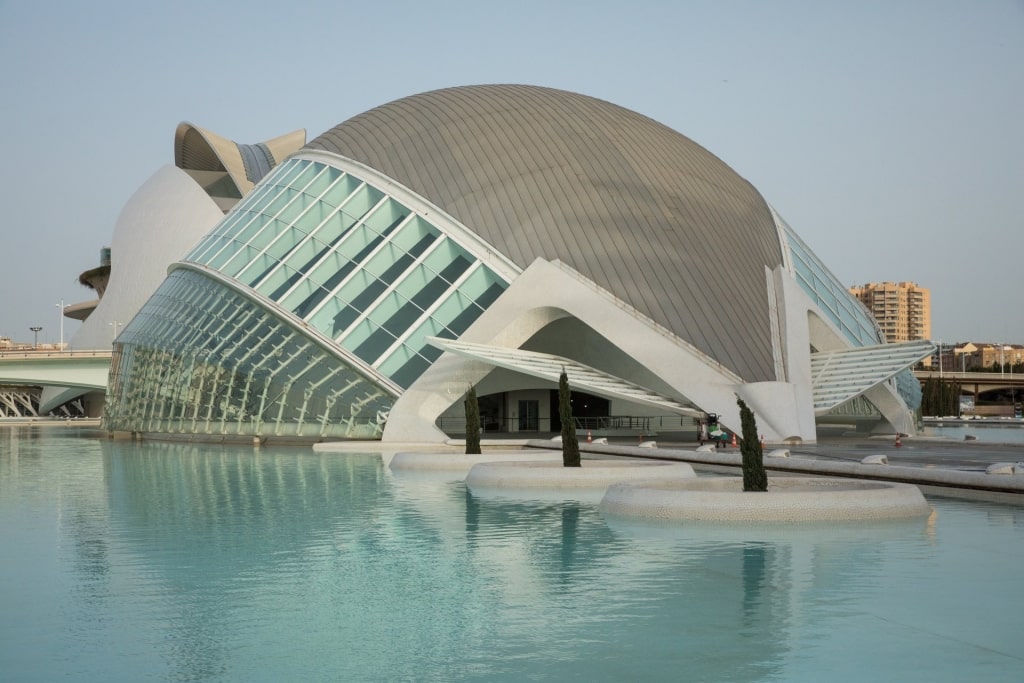
City of Arts and Sciences, Valencia
The unpredictable Turia River that once flowed through the center of Valencia turned out to be a blessing in disguise. The waterway had to be diverted around the city following a particularly bad flood in 1957, and its former bed has now been converted into a wonderful park.
This four-mile ribbon snakes through the center, blending ornate formal gardens with lawns, sports fields, and palm-lined avenues, with the old bridges still intact. One end of the park is overlooked by the dramatically curvy, shining glass and metal complex of the avant-garde City of Arts and Sciences, incorporating the opera house, aquarium, science museum, and an IMAX cinema.
The buildings were designed by renowned architects Santiago Calatrava and Félix Candela and are worth visiting for the sheer beauty of their form, even if you don’t go inside. Some visitors like to hire bicycles and cycle along the old river bed, just admiring the scenery.
Having said that, the Príncipe Felipe Science Museum is a great science center, especially if you’re visiting Europe with kids, while the Oceanogràfic is Europe’s largest aquarium with over 500 marine species.
Roman Theater, Cartagena
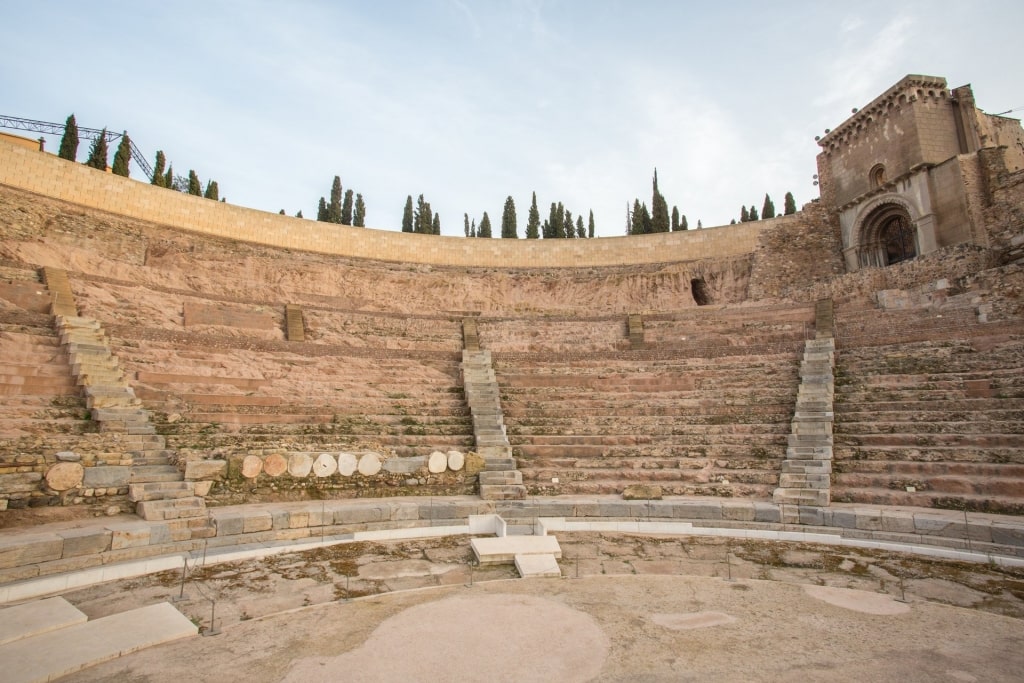
Roman Theater, Cartagena
Simply strolling around the lovely old city of Cartagena, trying mentally to peel back the layers of history all around you, is enough for many. But if you visit any one attraction, head for the Roman Theater Museum, just in front of the port.
This impressive amphitheater was built between the fifth and first centuries BC, and at its height, held some 6,000 spectators. Over the centuries, it fell into disrepair, one building after another being built on top of the ruins, including a marketplace and a bullring. Excavations only began in 1988, a mammoth task, as the ancient theater was completely covered by the city.
The visit starts in a small museum, displaying statues, columns, and earthenware discovered during the excavation. What’s interesting is that you enter the museum on the Town Hall Square and walk through an underground corridor, under existing buildings, emerging into the sunlight within the amphitheater itself, now beautifully restored.
Dalt Vila, Ibiza

Dalt Vila, Ibiza
The fortified medieval heart of Ibiza Town, Dalt Vila, which means “high town”, perches on a small hill overlooking the port. As a whole, it’s one of the most enchanting of Spain’s landmarks.
The whole area within the 16th-century ramparts in Ibiza is a UNESCO World Heritage Site, and it’s a blissful place to lose yourself. Enter through the Port Nou gate in the walls and you’re in another world of ancient cobbled alleys, medieval mansions, and sunlit balconies.
All roads lead uphill to the cathedral at the top, where you can gaze over the battlements and take in wonderful views of the port below and across the sparkling Mediterranean to the island of Formentera.
The superb archaeological museum is currently closed for renovations, but there are other compensations in Dalt Vila, not least quirky shops, galleries, and numerous restaurants with outdoor dining on leafy patios.
La Seu, Barcelona
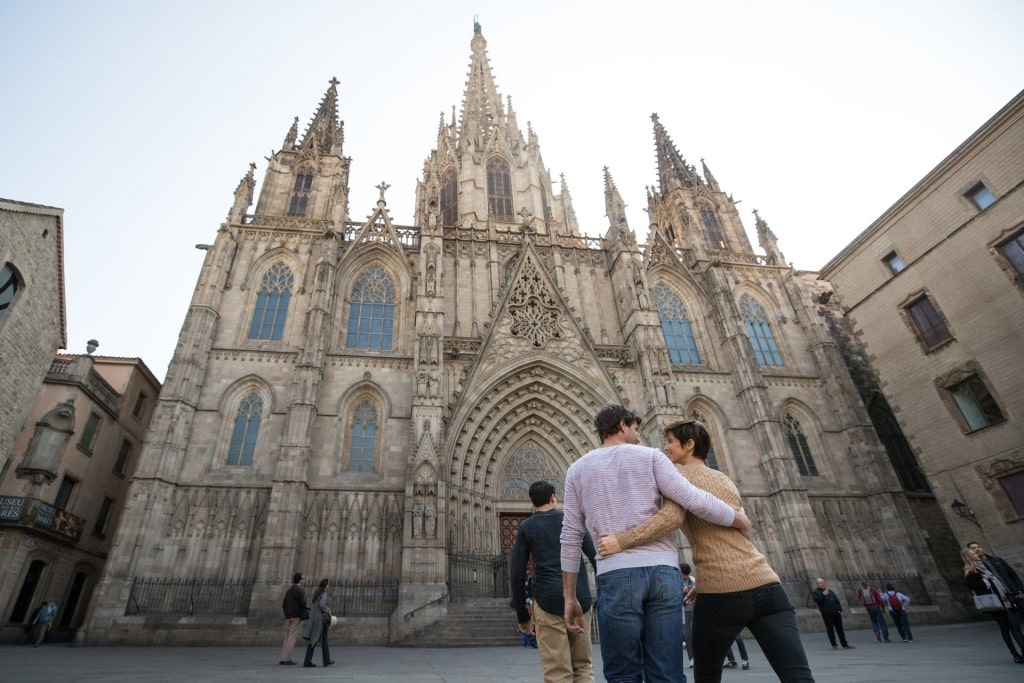
La Seu, Barcelona
Barcelona’s vast Gothic cathedral is sometimes overshadowed by the flashier Sagrada Familia but is nonetheless one of the city’s great monuments. It looms over the tangle of streets inside the old city walls that form the Gothic quarter.
La Seu took 600 years to complete and is dedicated to Santa Eularia, a 13-year old shepherdess who was martyred in 304 AD by the Romans for her Christian beliefs. She’s buried in a crypt below the altar. Today, 13 pure white geese, symbolizing her age and purity, inhabit the leafy cloister, a beautiful green oasis of palms and magnolias in the heart of the complex.
After your visit, head for Carrer Petritxol, a narrow lane famed for its chocolate shops, for churros, a famous Barcelona food made of fried strips of doughnut dipped in rich chocolate.
Catedral de Valencia, Valencia
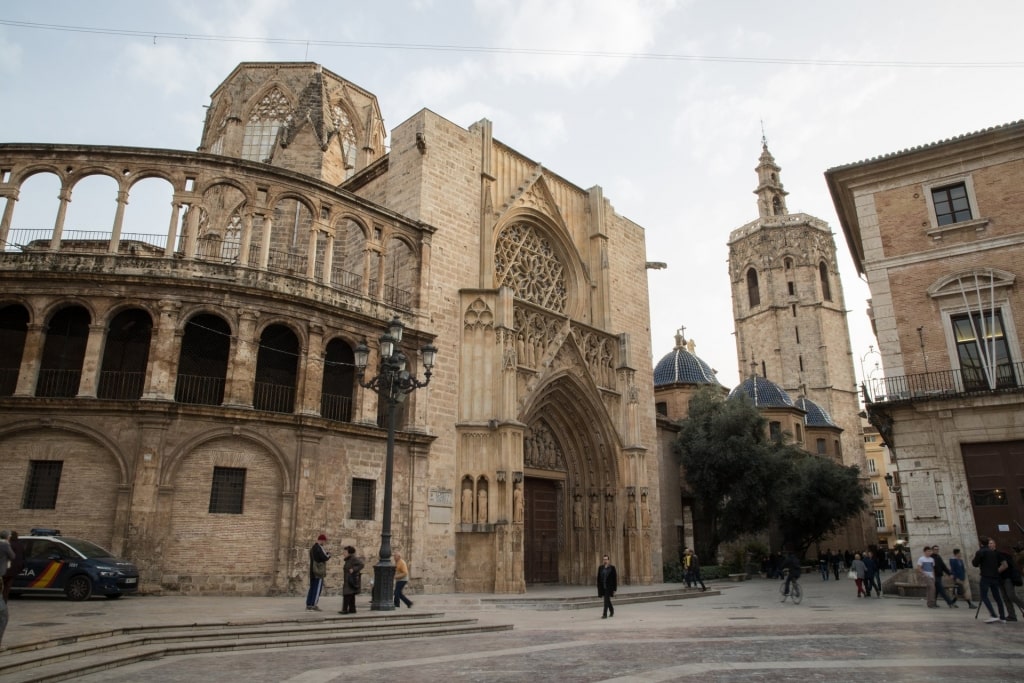
Catedral de Valencia, Valencia
The mighty Catedral de Valencia is a case in point when it comes to illustrating Spain’s colorful past. First, there was a Roman temple on this site, and later, a mosque. Construction on the current Gothic structure began in the 13th century.
What’s intriguing about the mighty cathedral in Valencia’s Old Town is that it houses what many believe to be the actual Holy Grail. On busy days, a line of pilgrims snakes around the Capella del Santo Calíz, within the ornate interior, to pay homage to the Grail, a cup carved from oriental agate stone and encrusted with jewels.
This aside, the cathedral’s interiors are magnificent, a lavish mélange of gothic, Romanesque, and baroque styles, angels painted in a starry sky overlooking the altar. The cathedral is located in the heart of this very walkable city, with shops and restaurants all around.
Tuck into an authentic paella, which originates in Valencia, to summon the energy for the climb up 207 steps of the cathedral’s Miguelete bell tower for panoramic views over the rooftops.
Royal Alcázar, Seville

Royal Alcázar, Seville
Seville’s royal palace is a perfect example of Mudéjar architecture, the style adopted by the Moors to blend Arab, Gothic, and Renaissance themes. Originally a fort in the 10th century, the palace has been expanded many times, the most lavish addition the Palacio de Don Pedro, added in the 14th century.
Here, you’ll see sunken gardens, elaborate artworks, intricate mosaics, and grand salons. The Salón de Los Embajadores, with an exquisite red, gold, and green-domed ceiling, is where Queen Isabella received Christopher Columbus. This is one Spain landmark for which you’ll need to plan ahead, as it’s understandably popular, not least because sections of the building are still used by today’s royal family.
While you’re in the city center of glorious Seville, stroll across the road from the Alcázar to the Giralda, a Moorish minaret that’s the symbol of the city. You can climb 308 feet to the top, walking on ramps built by the Moors wide enough to accommodate donkeys, for stupendous views. The tower was once used as an observatory and a platform from which to call the faithful to prayer, but now it’s the bell tower for the city’s cathedral.
La Seu, Palma

La Seu, Palma
You can’t miss Palma’s magnificent Gothic cathedral, La Seu, as it dominates one end of the curve of Palma Bay. This brooding hulk of a building, one of the tallest Gothic structures in Europe, is characterized by its rib-like flying buttresses and enormous rose window.
The Spanish church was started in the 14th century and received various additions over the years. There’s a touch of Antoni Gaudí inside in the decidedly contemporary crown of thorns that hangs over the altar. This isn’t actually a Gaudí piece, fans will be sorry to learn, but it was completed by one of his disciples.
La Seu lies on the edge of Palma’s intriguing Gothic Quarter, a tangle of alleyways lined with grand old mansions, secret courtyards, and dark little cellar bars that provide shady refuge from the heat and tasty tapas to accompany a lunchtime glass of wine after your visit.
Tower of Hercules, La Coruña
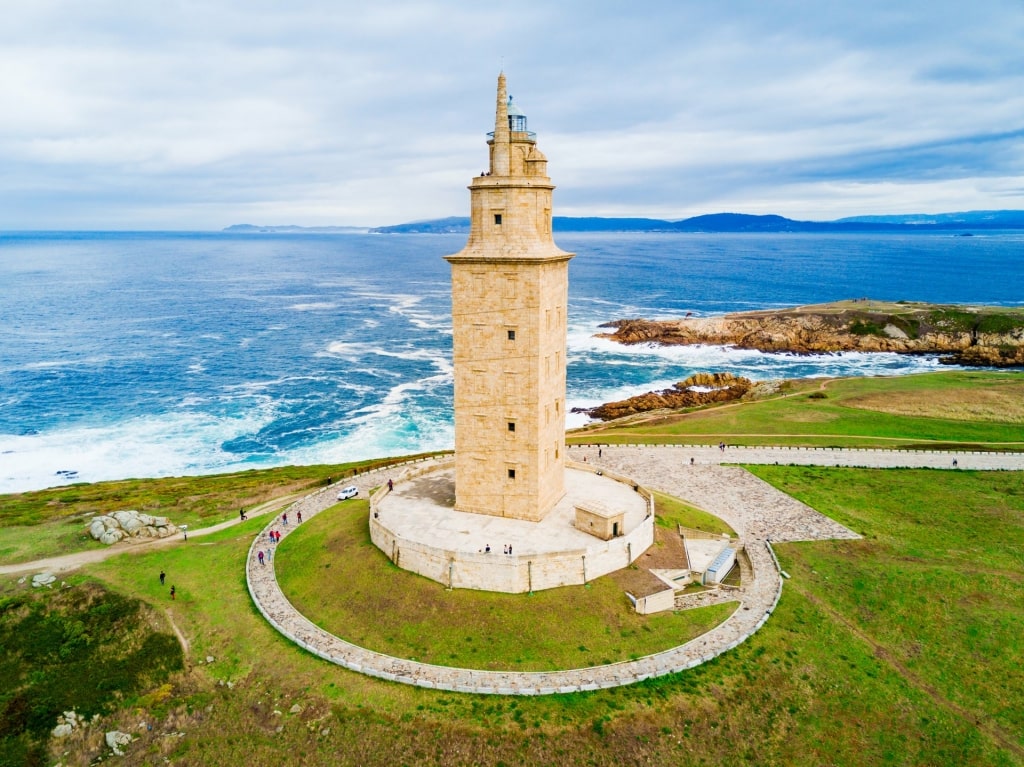
Tower of Hercules, La Coruña
The oldest Roman lighthouse still in use, the majestic Torre de Hércules guards a grassy, wind-blown headland on the northern tip of this bustling port city. There’s been a tower here for some 2,000 years. While the outer walls were added at the end of the 18th century, the inside, up which you can climb 200 steps, is the original Roman structure.
Around the tower, there’s an eclectic range of attractions, from a sculpture garden to Iron Age rock carvings and an ancient Muslim cemetery. Getting here is easy from downtown, and the views from the top of the waves pounding the rocks at the base of the cliff are magnificent.
Park Güell, Barcelona

Park Güell, Barcelona
Visit Park Güell, in the northern part of the city, to be immersed in Antoni Gaudí’s surrealist fantasy world. The curvy pathways here will have you wandering past red-and-blue mosaics, wavy benches, and Gaudí’s many creative, dreamlike structures.
This whimsical park, initially envisioned by Barcelona’s upper class as a garden city, was sold to the municipality in 1926 by Eusebi Güell’s relatives and is now a cherished public space. Gaudí’s playfulness pervades every design choice, evoking natural shapes and colors.

El Drac in Park Güell, Barcelona
During your visit, be on the lookout for the famous mosaic salamander “El Drac,” which awaits you at the top of the monumental staircase. This lizard’s multi-hued scales stand as a testament to Gaudí’s love of color and intricate details; it’s a well-known Spanish landmark, and you will see it replicated in miniatures, key rings, and hundreds of Instagram posts.
Also, don’t miss a chance to climb up to the Greek Theatre terrace for awe-inspiring views of Barcelona and the glinting Mediterranean beyond.
Bellver Castle, Palma de Mallorca

Bellver Castle, Palma de Mallorca
When it comes to famous landmarks in Spain, be sure you add the 14th-century Gothic Bellver Castle in Mallorca to your “must-see” list.
To reach this fortress and former prison, you‘ll need to hike to the top of a hill just outside the city, where you will also be treated to one of the best views of Palma’s rooftops and the sparkling Bay of Palma.

Bellver Castle, Palma de Mallorca
The Spanish castle itself, commissioned in the early 1300s by King James II of Mallorca, features a circular floor plan. As you walk around its rounded towers and stonework, you can almost hear the royal processions and clank of medieval swords of ages past.
The Museu d’Història de la Ciutat, situated inside the castle, offers more information about the castle and the island’s heritage, from the Roman era to the bustling destination that this corner of Spain has become today.
Nerja Caves, near Málaga

Nerja Caves, near Málaga
Deep beneath the hills of the Spanish beach town of Nerja, you’ll encounter some amazing caves carved out by Mother Nature.
When you enter the Nerja Caves, stalactites and stalagmites stretch from the floor to the cave roof in a subterranean landscape of mineral and rock.
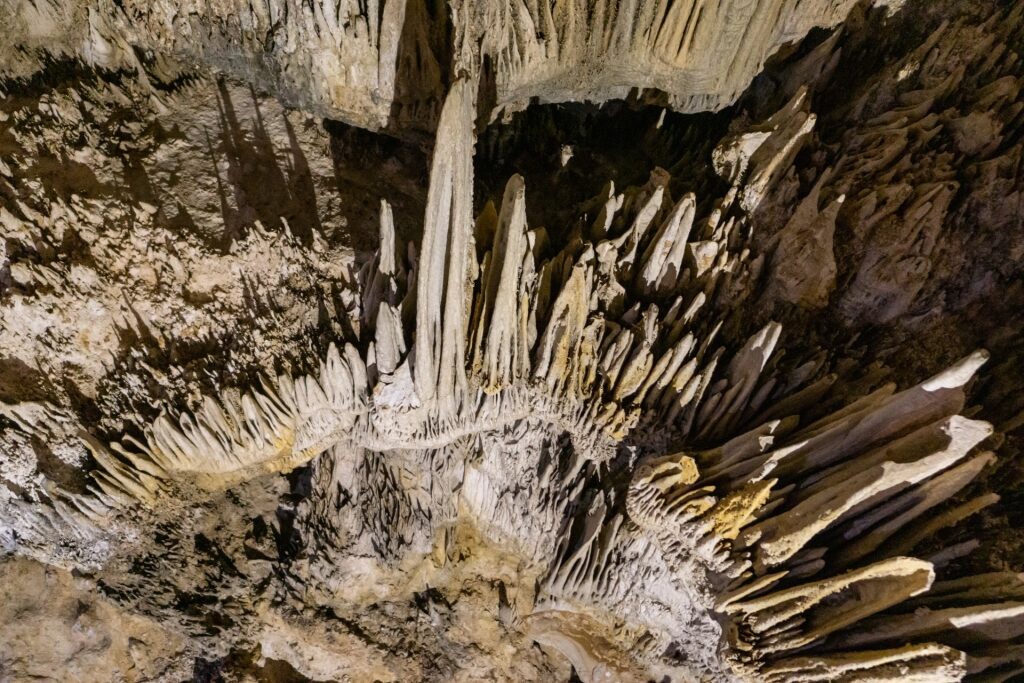
Nerja Caves, near Málaga
Limestone formations aside, the Neanderthal cave paintings here are among the oldest in Europe, dating back over 40,000 years. As you stroll along the walkways lined with lights, you’ll be walking in the footsteps of prehistoric humans, who once sought refuge in these cavernous hollows.
In summer, concerts are held within the caves’ Hall of the Waterfall amphitheater, with the sounds of music echoing beautifully off the stone walls, adding to the Nerja Caves’ mystical charm.
Montserrat, Barcelona

Montserrat, Barcelona
Rising out of the Catalan landscape, the saw-toothed peaks of Montserrat are hard to miss, with their jagged silhouette that has inspired legends across the centuries.
After you make it to this “serrated mountain,” either by bus, car, or the very steep Aeri de Montserrat cable car, you’ll find, concealed among the rocky outcrops, the Benedictine Monastery of Santa Maria de Montserrat, dating back to 1025.
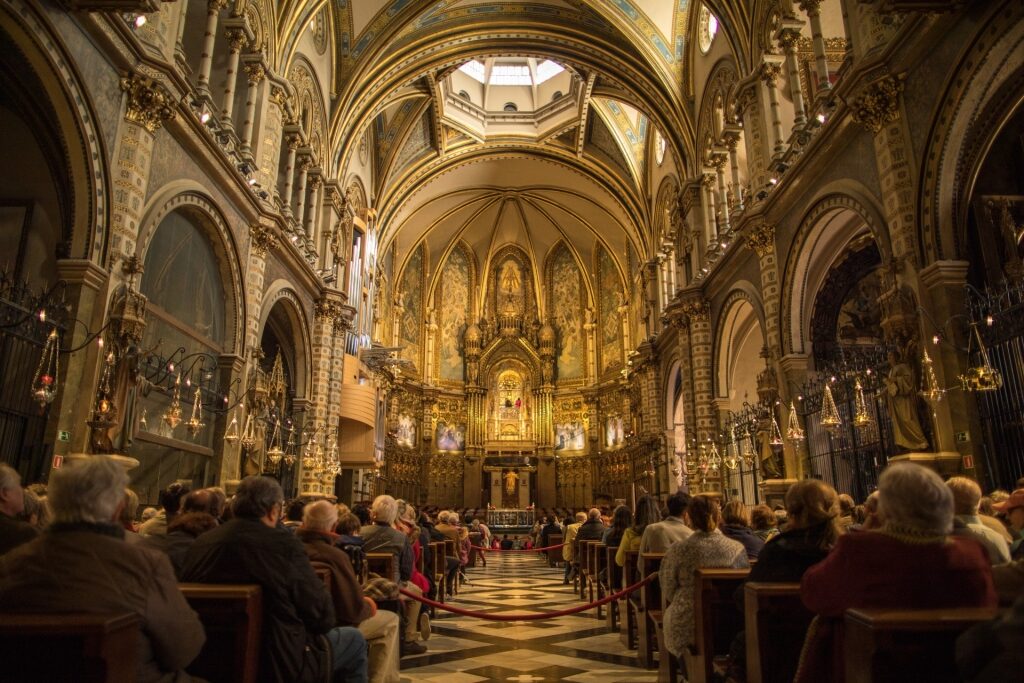
Benedictine Monastery of Santa Maria de Montserrat, Barcelona
This monastery is a spiritual pilgrimage site that houses the celebrated Black Madonna statue, which pilgrims and tourists from all over the world come to visit.
You can hike—or hop on board the Sant Joan Funicular—to head higher still, to the summit, for treks across Montserrat’s ridgeline with views over the surrounding hills and the distant Mediterranean on clear days.
Read: Three Days in Barcelona
Cádiz Cathedral, Cádiz

Cádiz Cathedral, Cádiz
Cádiz Cathedral is a gorgeous building, located in the sun-drenched Andalusian city of Cádiz. Standing by the waterfront, this cathedral is a magnificent mix of Baroque and Neoclassical architecture, with a golden dome that gleams in the sunlight.
The cathedral’s construction began in 1722 and took more than 100 years to complete, which is why you’ll see different architectural styles throughout.
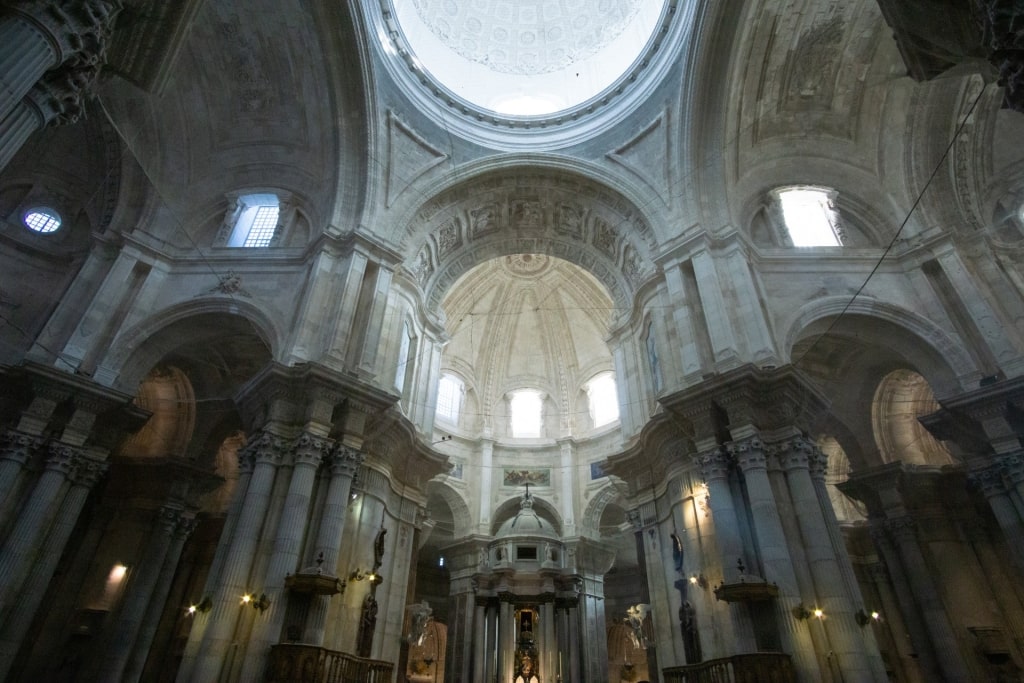
Cádiz Cathedral, Cádiz
Inside, you’ll be struck by the soaring ceilings, stained glass, and exquisitely decorated altars. The most photographed part of the cathedral is likely the bell tower, which you can climb for views of the old town and the Atlantic Ocean.
You can also dip down into the cathedral’s crypt, featuring an expansive room that serves as the resting place for some of the most renowned of Cádiz’s deceased, including the pianist and composer Manuel de Falla.
Maspalomas Dunes, Gran Canaria
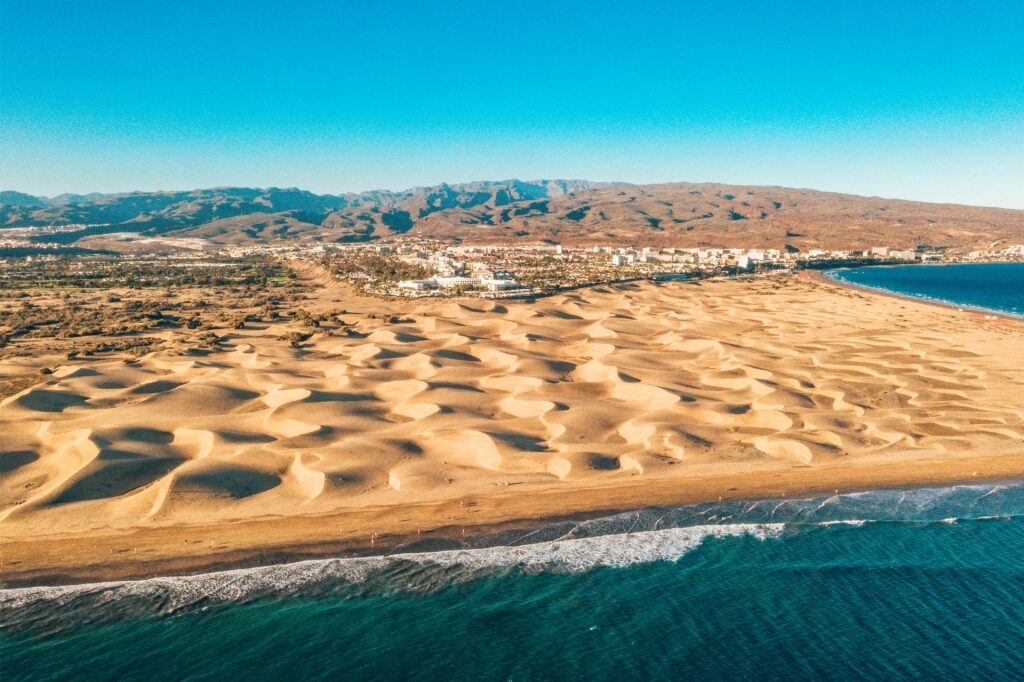
Maspalomas Dunes, Gran Canaria
As well as man-made masterpieces, there are plenty of natural Spanish landmarks. Walking across these rolling hills of golden sand by the sea is a poetic, or even romantic, thing to do, which is why the Maspalomas Dunes stand out as one of the most beautiful landscapes in Spain.
Stretching along the southern coast of Gran Canaria, these rolling dunes ripple in the wind, creating constantly shifting natural designs. You can walk across the sand here barefoot or use the boardwalks to support the delicate ecosystem below.
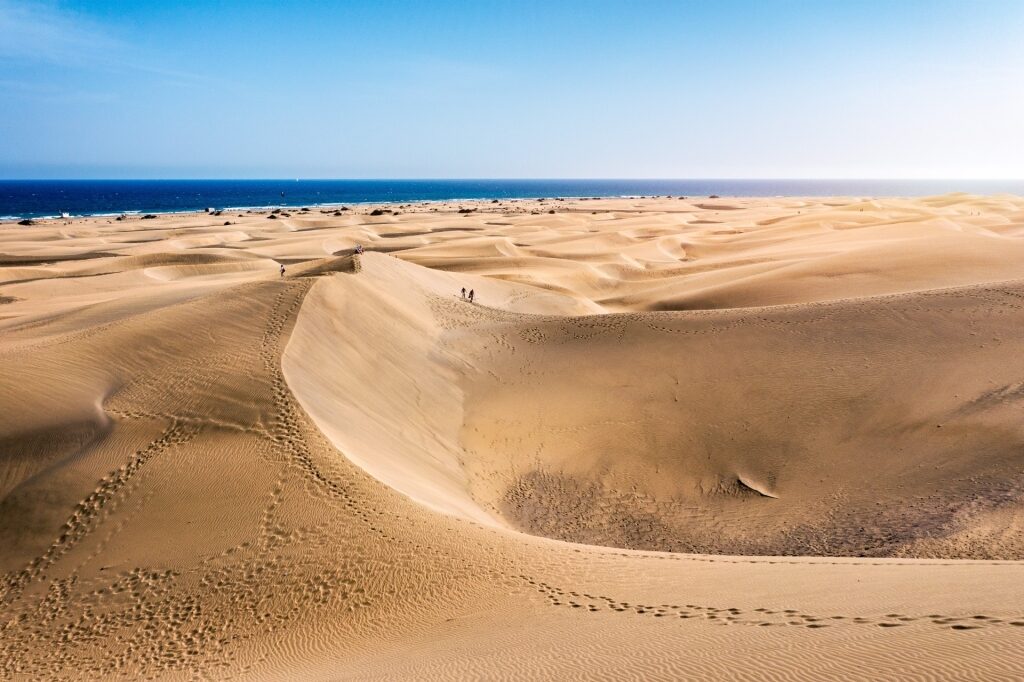
Maspalomas Dunes, Gran Canaria
Although the dunes, in photos, look like an isolated desert, they are actually part of a nature reserve filled with rare vegetation, as well as different bird species, such as egrets, sandpipers, and turnstones, which frequent the nearby La Charca lagoon.
Whether you’re here for photography, relaxation, or to lose yourself in the sand, these picturesque dunes are a fine example of the impressively varied landscapes of Gran Canaria.
Basílica de Santa Maria del Mar, Barcelona
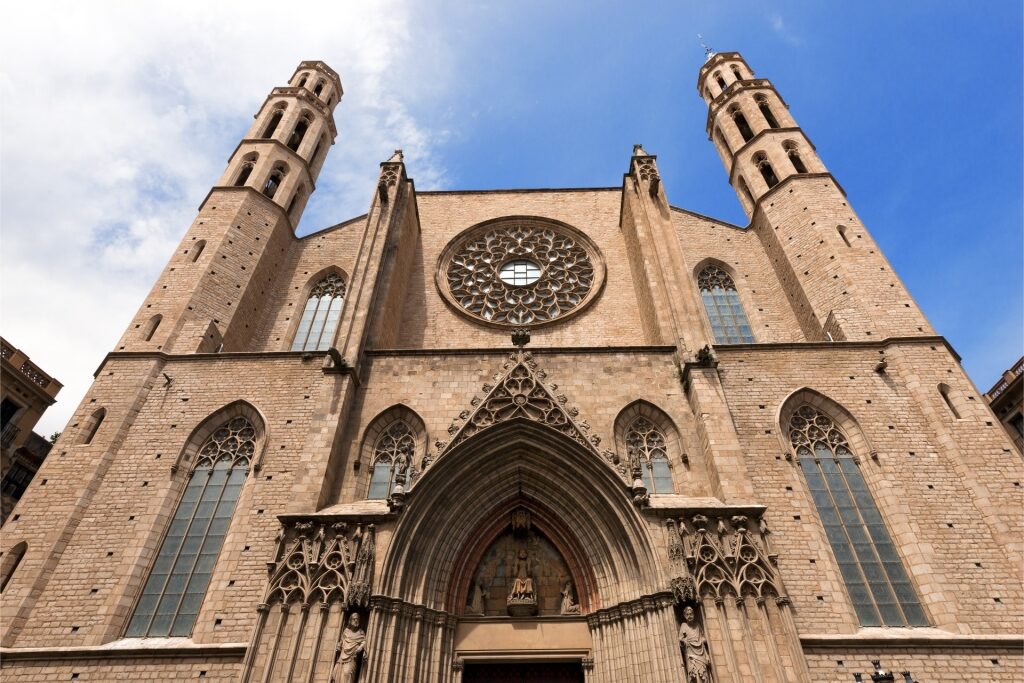
Basílica de Santa Maria del Mar, Barcelona
Situated in Barcelona’s El Born neighborhood, the Basílica de Santa Maria del Mar is a splendid example of Catalan Gothic architecture.
Built between 1329 and 1384, this grand “cathedral of the people,” with its distinctive octagonal columns, was funded by the city’s merchants, sailors, and artisans. Its slim columns and large, open nave create an airy presence not typical of most Gothic churches.
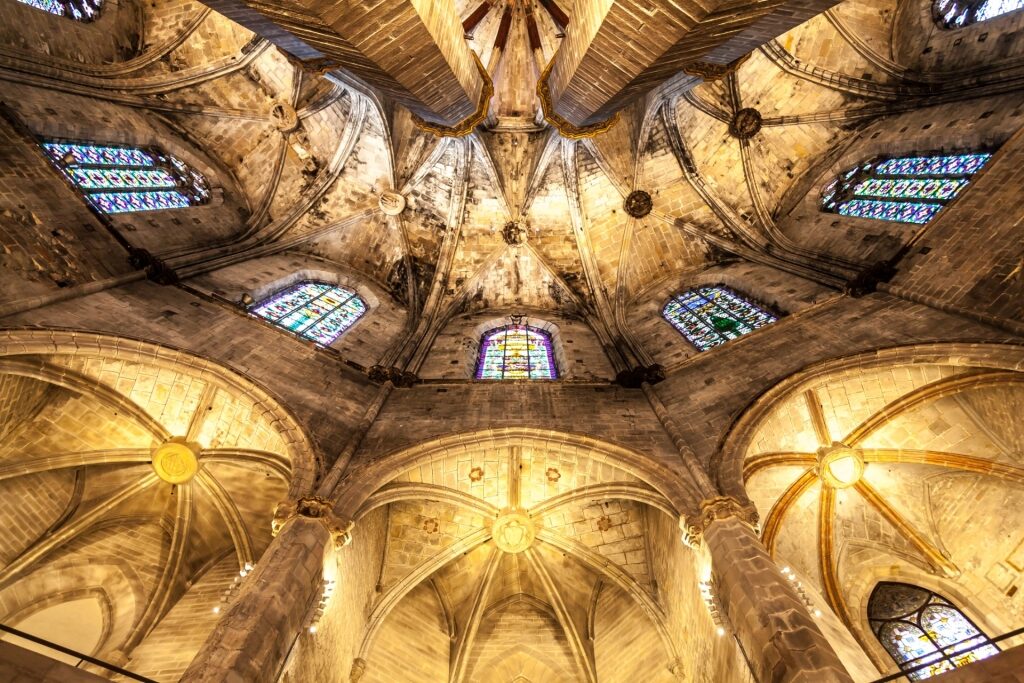
Basílica de Santa Maria del Mar, Barcelona
While you’re inside, check out the large and extravagantly decorated rose window and the lovely stained-glass window depicting the Ascension.
For further reading, consider the historical fiction novel Cathedral of the Sea, by Ildefonso Falcones, which tells the story of the people who built the Basílica de Santa Maria del Mar.
Santiago de Compostela Cathedral, Galicia

Santiago de Compostela Cathedral, Galicia
Santiago de Compostela is not just a city; it’s the destination of one of the most well-trodden pilgrimage paths in Europe, the Camino de Santiago.
At its heart stands its breathtaking cathedral, dating back to 1075 and consecrated in 1211, within which Saint James the Apostle’s remains are thought to lie buried.
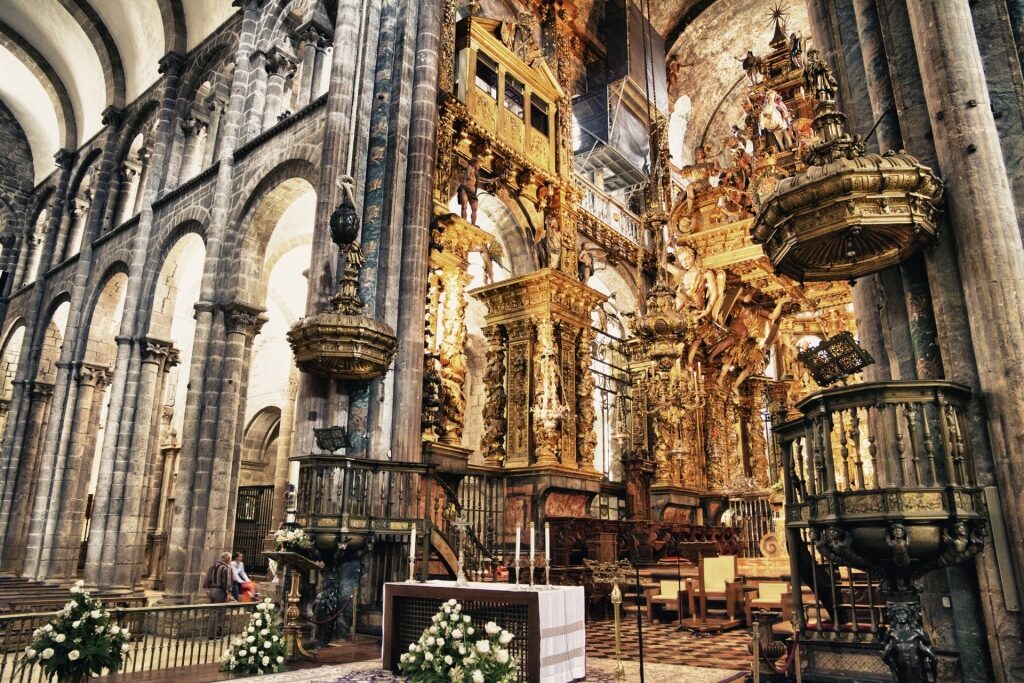
Santiago de Compostela Cathedral, Galicia
When you come upon this building’s ornate Baroque façade and its Romanesque Pórtico da Gloria after a long journey—regardless of how you’ve arrived—your eyes will fall upon a magnificent cathedral that binds Romanesque, Gothic, and Baroque designs together.
The entire Spanish city of Santiago is worth exploring. From the granite streets and vibrant squares in the Old Town to the crowd of students, pilgrims, and locals, there is a tangible feel of history and faith here.
Casa Batlló, Barcelona
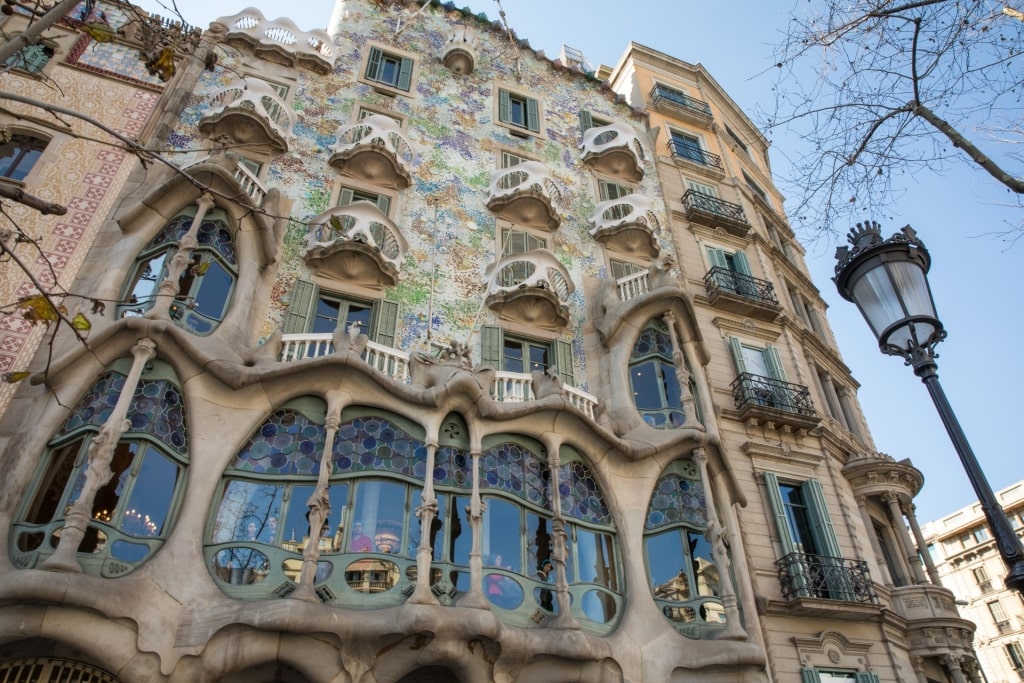
Casa Batlló, Barcelona
As you stroll along Barcelona’s iconic Passeig de Gràcia, the wavy, nature-inspired curves of Casa Batlló might cause you to do a double-take.
Antoni Gaudí designed this building in the early 1900s, creating an architectural wonder with an undulating façade, colored mosaics, and balconies that resemble bones.

Casa Batlló, Barcelona
Stepping inside is like entering a fairytale, making it one of the best things to do in Barcelona with kids. The inner lightwell, which Gaudí adorned with a sea of blue tiles, pulls your eyes toward the ceiling. As you wander through the house, you will appreciate how Gaudí made such excellent use of natural light in his designs.
Even the roof of this quirky building, with its colorful dragon-scaled tiles and strange-looking chimneys, is a work of art.
Málaga Cathedral, Málaga

Málaga Cathedral, Málaga
Málaga Cathedral, built primarily in the 16th century on the site of an ancient mosque, features a blend of Renaissance and Baroque design, making it one of the most notable religious landmarks in Spain.
The cathedral took longer to finish than planned. As a result, one of its towers remains unfinished to this day. In fact, the unfinished aspect has earned the cathedral the nickname La Manquita or “the one-armed lady.”
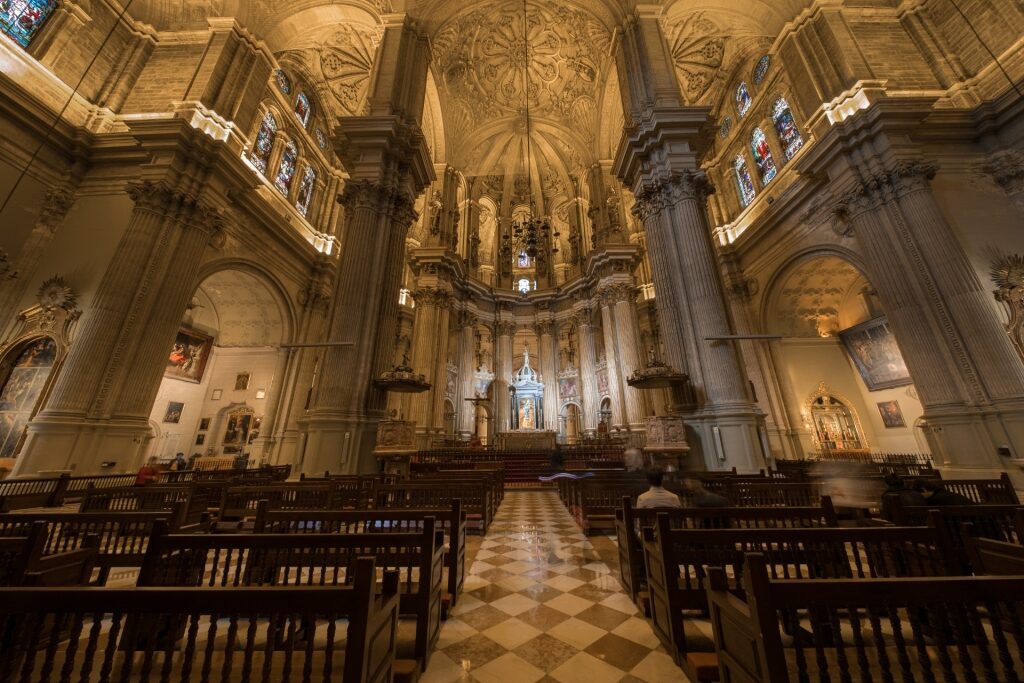
Málaga Cathedral, Málaga
Inside, as you make your way along the magnificent nave, take note of the elaborately carved wooden choir stalls and filigreed windows. The way in which the sun filters through the windows creates a golden, soft light over the marble floors. The art on display is magnificent; Lombardo’s Beheading of St. Paul, while grisly, is exquisite.
After soaking in the beauty of the interior, climb up onto the roof for spectacular views of Málaga. You’ll be able to see the Alcazaba fortress, the streets down below, and the glimmering Mediterranean Sea in the distance.
Doñana National Park, near Seville

Doñana National Park, near Seville
Doñana National Park is unique when it comes to Spanish natural landmarks. With its marshes, lagoons, sand dunes, and pine forests, Doñana is one of Europe’s most significant wetlands—and a UNESCO World Heritage Site to boot.
You can explore this park by jeep, horse, or simply on a guided tour on foot. Doñana National Park also happens to be one of the last places in the world where you might be able to catch a glimpse, if you’re lucky, of the critically endangered Iberian lynx in the wild.

Iberian lynx
Flocks of flamingos, Spanish imperial eagles, and other bird species migrate through the park every year, making it heaven for birdwatchers.
Cíes Islands, Vigo
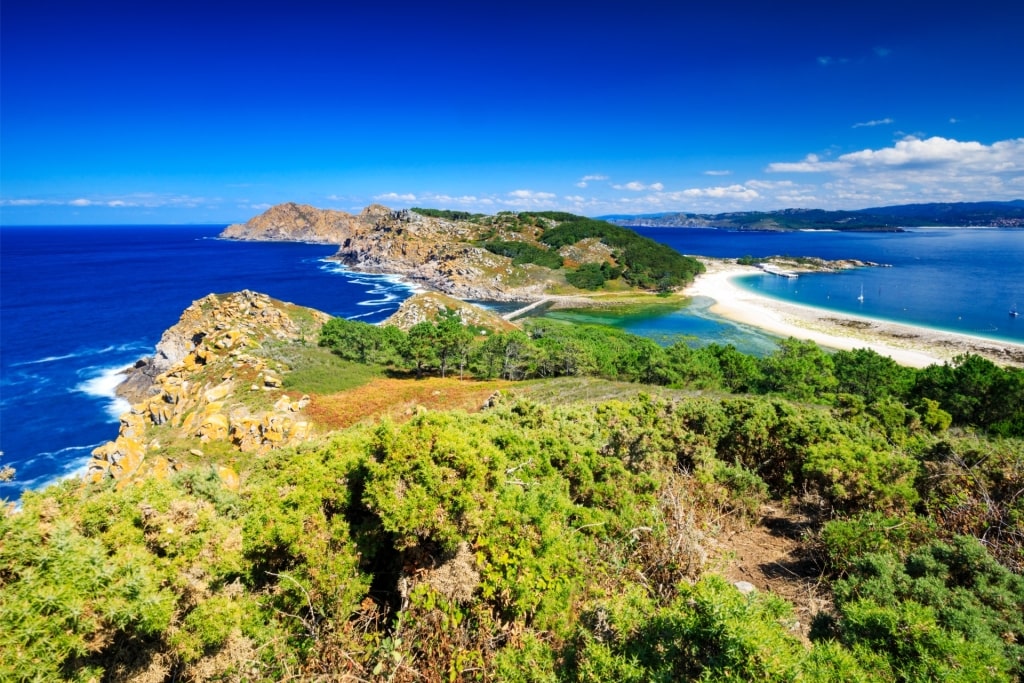
Cíes Islands, Vigo
The Cíes Islands, extending out along the Galician coast near Vigo, have often been labeled as the “Galician Caribbean” by locals, and for good reason.
If you’re fortunate enough to make it to this exquisite archipelago, for which you need to book ahead, you will find that its loveliness lies in its unspoiled, raw beauty. As soon as you disembark the ferry, the aroma of pine is carried on the breeze.
The Spanish island chain, which is part of the Atlantic Islands National Park, has white sandy beaches that stretch as far as the eye can see, crystal-clear seas, and rocky cliffs where seabirds nest.
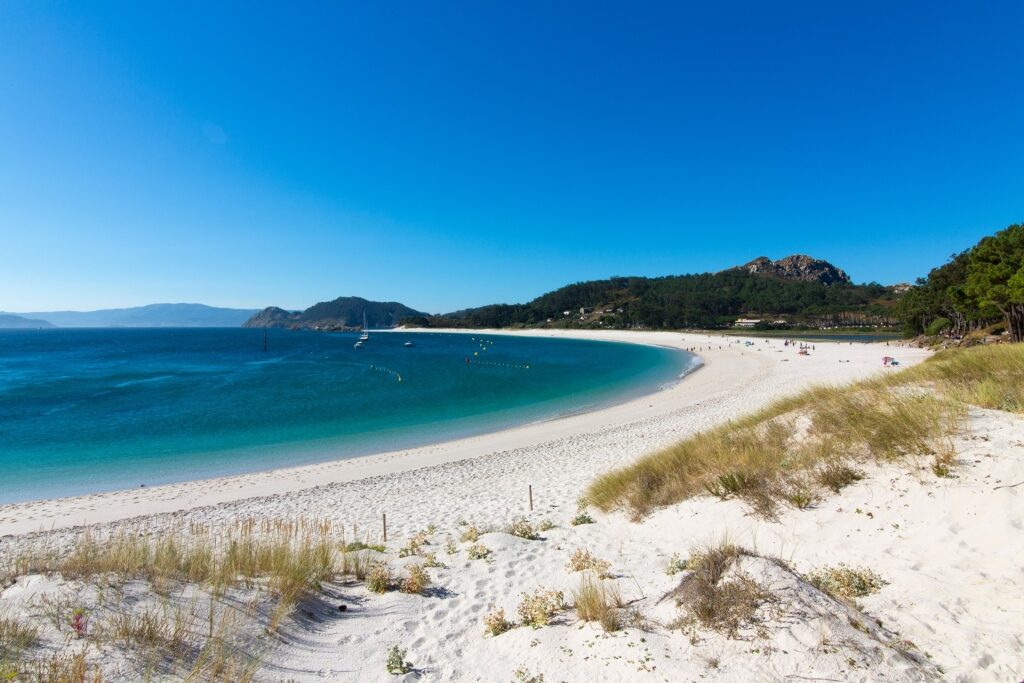
Cíes Islands, Vigo
Rodas Beach, situated on a narrow strip of land between two islands, is regarded as one of the world’s most photogenic stretches of sand.
There are no hotels or cars on the Cíes Islands, which only adds to their charm. You might spend the day walking through eucalyptus forests, bathing in the islands’ coves, or simply lying on the beach, enjoying watching sailboats pass by.
Caves of Drach, Palma de Mallorca
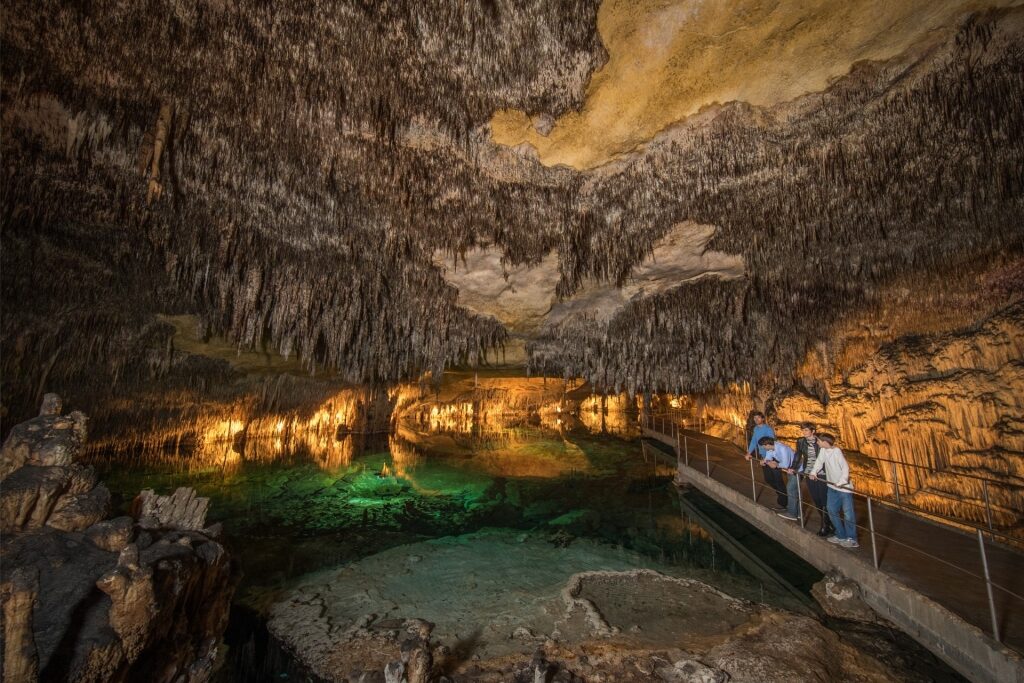
Caves of Drach, Palma de Mallorca
Mallorca’s Caves of Drach, which stretch around two and a half miles beneath the island’s eastern coastline, are composed of hollowed-out chambers filled with stalactites, stalagmites, and subterranean lakes. The caves, first mapped out in the late 19th century, have become a well-known Spanish landmark.
The main attraction here is Lake Martel, one of the largest underground lakes in the world. The lake serves as an eerily romantic setting for short-duration live classical music concerts, which take advantage of the natural acoustics.
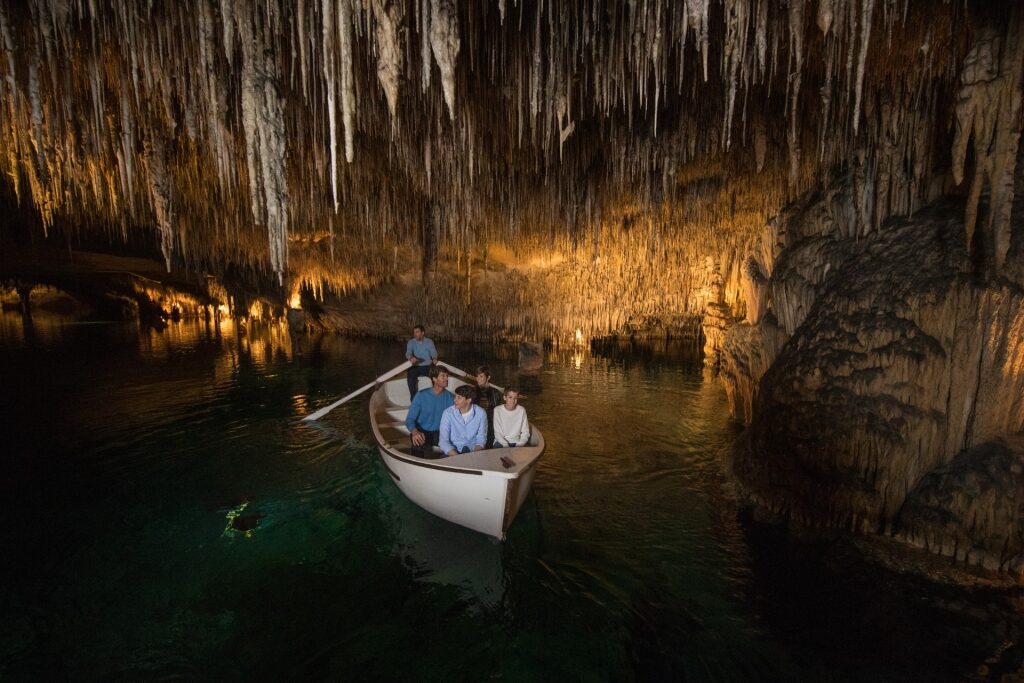
Lake Martel, Palma de Mallorca
A guided tour will take you past the cavernous Black Cave, the different formations inside the Cave of the French, and Drach’s other caverns.
FAQs
What are some of the most photogenic UNESCO World Heritage Sites in Spain?
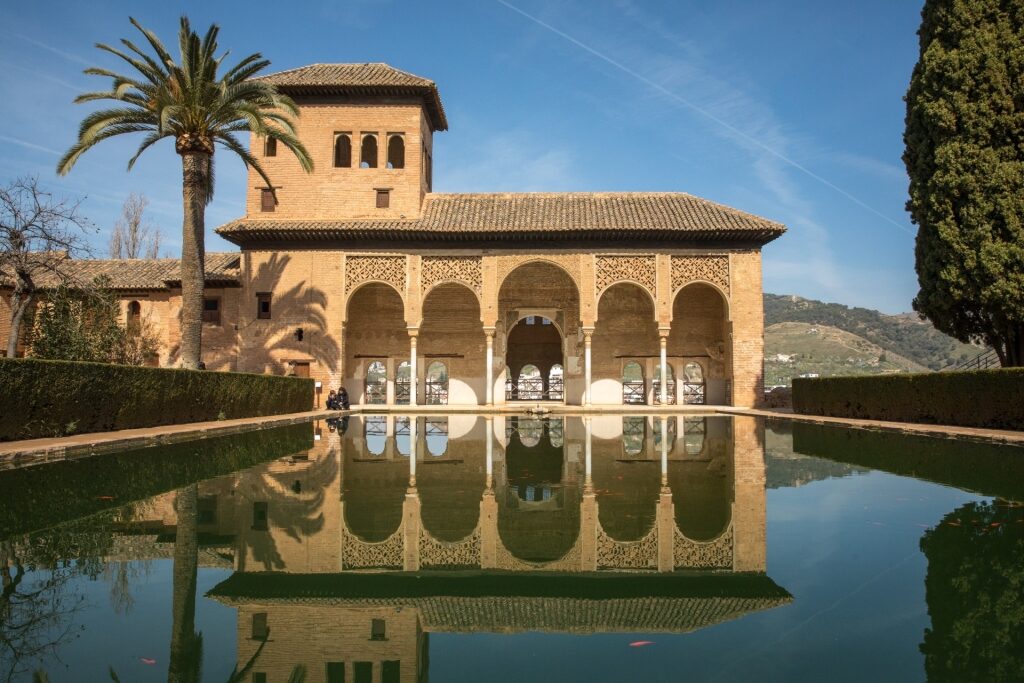
Alhambra Palace, Granada
Some of the most picturesque UNESCO landmarks Spain is known for include the mighty Alhambra in Granada, colorful Park Güell in Barcelona, and Santiago de Compostela Cathedral in Galicia.
Which historic landmarks are located in southern Spain?

Cádiz Cathedral, Cádiz
Prominent landmarks in southern Spain include the previously mentioned Alhambra, the Mezquita-Catedral of Córdoba, Cádiz Cathedral, and the Alcázar of Seville. Many of these sites are fine examples of Moorish, Gothic, and Renaissance architecture.
Are Spain’s most popular landmarks, museums, and historical sites open year-round?

Montserrat, Barcelona
The majority of Spain’s most popular landmarks, museums, and historic sites are open year-round, though hours may vary depending on the season and/or public holidays. Check ahead for the opening hours of smaller sites, particularly in smaller villages or towns.
What are some of the most prominent religious landmarks to visit in Spain?
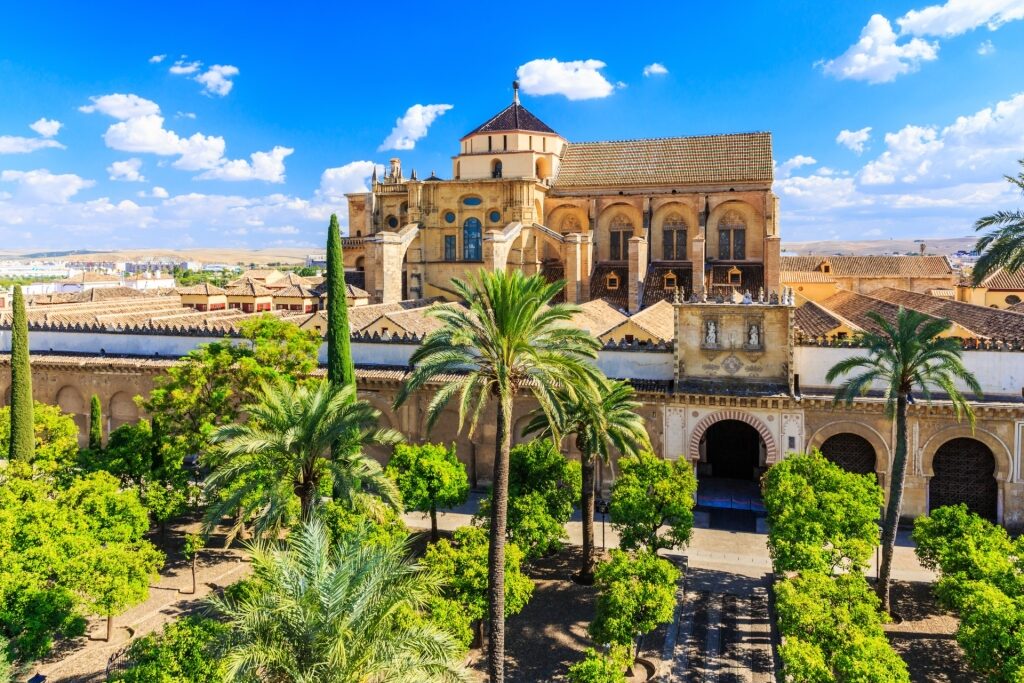
Mezquita-Catedral of Córdoba
Notable religious landmarks include the Sagrada Família in Barcelona, the Santiago de Compostela Cathedral, and the Mezquita-Catedral of Córdoba.
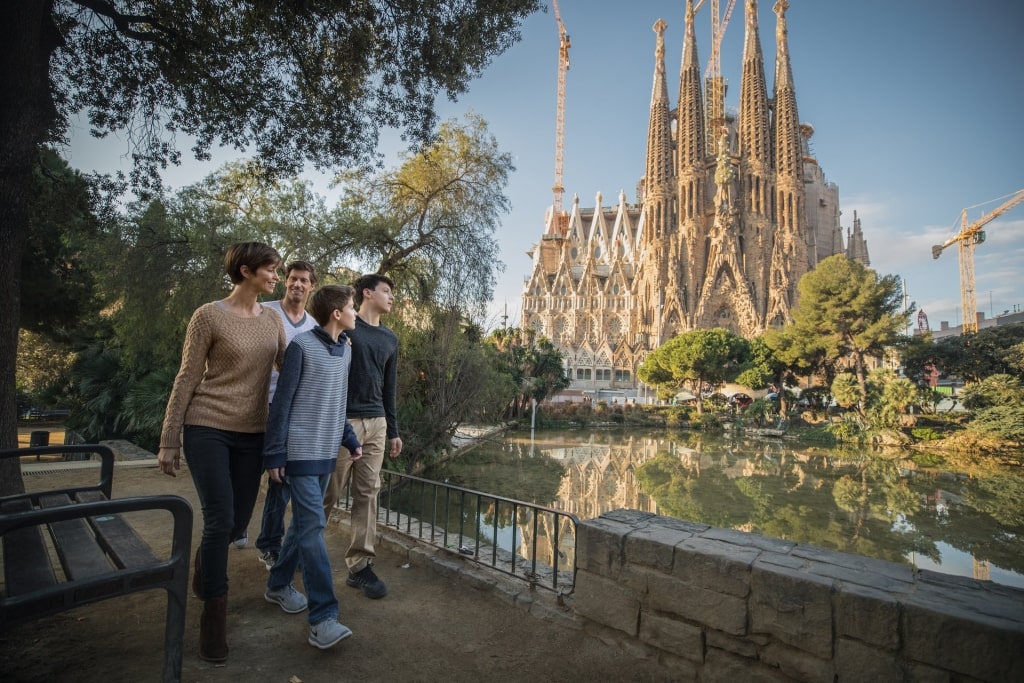
La Sagrada Famíla, Barcelona
Ready to discover Spain’s rich culture for yourself? Start planning your next European itinerary now and browse our exciting cruises to Spain on our website.


